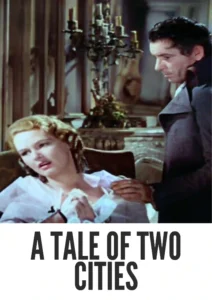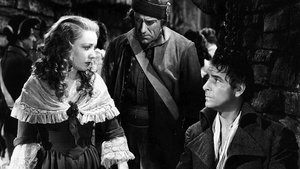Contact: info@alwanfilm.com
Video Sources 0 Views

Synopsis
A Tale of Two Cities 1935 Colorized Review: A Cinematic Adaptation of Dickens’ Masterpiece

Introduction
In the pantheon of literary adaptations, few films capture the spirit of the source material as faithfully and powerfully as A Tale of Two Cities (1935). Directed by Jack Conway and adapted from Charles Dickens’ classic novel, this film is a stirring depiction of the turbulent French Revolution and its profound impact on the lives of its characters. A towering achievement for its time, A Tale of Two Cities not only brings Dickens’ words to life but also showcases the innovation of 1930s cinema, with its dramatic set pieces, compelling performances, and intricate plot. This review will explore the story, cast, thematic depth, and historical significance of the film, while considering its place in the landscape of early Hollywood adaptations.
Check The Full Colorized Movies List
Check Our Colorized Movies Trailer Channel
Understanding A Tale of Two Cities 1935 Colorized: Director, Cast, and Genre
Director’s Vision
Jack Conway, a seasoned director under MGM’s studio system, helmed A Tale of Two Cities with an eye for grandeur and historical detail. Known for his ability to balance epic scope with intimate character development, Conway succeeded in making the complex narrative accessible and emotionally resonant for audiences. His direction focused on capturing the duality of the two cities, London and Paris, during the late 18th century—a contrast between the relative peace of England and the revolutionary upheaval of France. The film’s pacing, use of visuals, and the interplay between the personal and the political give it a timeless quality that still resonates today.
The Iconic Performance of Actors
The cast of A Tale of Two Cities (1935) is headlined by the charismatic Ronald Colman, who plays the disillusioned yet noble lawyer, Sydney Carton. Colman’s portrayal of Carton is perhaps one of the finest performances of his career, capturing the complexity and inner conflict of a man burdened by his wasted potential. His famous line, “It is a far, far better thing that I do, than I have ever done,” is delivered with such quiet conviction that it remains one of the most memorable moments in film history.
Elizabeth Allan plays Lucie Manette, the gentle and kind-hearted woman around whom much of the story revolves. While Lucie is often portrayed as a somewhat passive character in the novel, Allan brings a warmth and strength to the role, making her a sympathetic and essential presence in the film. Basil Rathbone’s performance as the aristocratic villain, Marquis St. Evrémonde, is chilling in its cold indifference, providing the film with a necessary counterbalance to Carton’s emotional arc.
Exploring the Genre
A Tale of Two Cities (1935) fits within the historical drama genre, a category known for bringing pivotal moments in world history to the big screen. The film goes beyond being a simple period piece, however, as it incorporates elements of melodrama and political thriller. The revolutionary backdrop creates an intense atmosphere of suspense, with looming threats of violence and betrayal that keep viewers engaged throughout. The film’s exploration of themes such as sacrifice, love, and redemption, all set against the chaos of revolution, makes it a rich, multi-layered work of art.
Exploring the World of A Tale of Two Cities 1935 Colorized: Plot and Characters
Detailed Synopsis
The story of A Tale of Two Cities (1935) follows the intertwined fates of several key characters during the years leading up to and following the French Revolution. The film opens in London, where we meet Lucie Manette (Elizabeth Allan), who is informed that her long-lost father, Dr. Alexandre Manette (Henry B. Walthall), has been released from an 18-year imprisonment in the Bastille. Lucie and her father return to England, but their peaceful life is soon disrupted by the political unrest sweeping across France.
Enter Sydney Carton (Ronald Colman), a brilliant but dissipated lawyer who is both fascinated by Lucie’s beauty and kindness and tormented by his own sense of failure. Carton’s life takes a dramatic turn when he becomes involved in the trial of Charles Darnay (Donald Woods), a French aristocrat who has fled the Revolution and now lives in England. Darnay, who is secretly the nephew of the cruel Marquis St. Evrémonde (Basil Rathbone), is accused of treason but is saved by Carton’s quick thinking and keen legal mind.
As the Revolution intensifies, Darnay returns to France to help an old family servant but is quickly arrested and sentenced to death by guillotine for the crimes of his aristocratic ancestors. In the film’s climactic moments, Carton makes the ultimate sacrifice, switching places with Darnay in prison and going to the guillotine in his stead. His selfless act of love for Lucie and her family cements his legacy as one of Dickens’ most tragic yet heroic characters.
The Complex Protagonist and Memorable Supporting Characters
Sydney Carton is undoubtedly the heart of the film. His journey from a cynical, self-loathing drunkard to a man capable of the ultimate act of redemption is both inspiring and deeply moving. Colman’s performance elevates the character, bringing nuance and depth to his internal struggles.
Lucie Manette, while a more passive character, serves as the emotional anchor for many of the male figures in the story. Her goodness and purity are what drive Carton to better himself, and her love for Darnay is portrayed with a quiet dignity.
Supporting characters, such as Dr. Manette, who suffers greatly from the trauma of his imprisonment, and Madame Defarge (Blanche Yurka), the vengeful revolutionary with a thirst for aristocratic blood, further enrich the narrative. Each character represents a different facet of the time period, from the suffering of the downtrodden to the excesses of the aristocracy.
The Art of Film Adaptation
Understanding the Process
Adapting a complex literary work like A Tale of Two Cities for the screen is no easy feat. Dickens’ novel is sprawling, with numerous subplots and a large cast of characters. Screenwriters W.P. Lipscomb and S.N. Behrman had the difficult task of condensing the novel’s events while maintaining its emotional and thematic core.
One of the challenges they faced was how to translate the novel’s intricate social commentary and rich character development into a cinematic form that could engage a 1930s audience. The solution was to focus on the personal stories of Carton, Lucie, and Darnay, while still maintaining the broader context of the Revolution. This allowed for a more streamlined narrative that didn’t sacrifice the novel’s essential themes.
Dickens’ Literary Influence on Cinema
Dickens and Early Hollywood
Charles Dickens’ works have long been a source of inspiration for filmmakers. His novels, with their vivid characters, dramatic plots, and sharp social criticism, lend themselves well to cinematic adaptation. The 1935 version of A Tale of Two Cities was part of a larger trend in early Hollywood to adapt classic literature for the screen, offering audiences both entertainment and a sense of cultural refinement.
Dickens’ influence on cinema extends beyond direct adaptations. His narrative techniques, such as his use of suspense, his attention to social injustice, and his exploration of complex moral dilemmas, have shaped the storytelling methods of filmmakers for decades. In A Tale of Two Cities, these elements are on full display, as the film weaves together personal drama with political revolution, all while addressing the larger themes of sacrifice and redemption.
The Revolutionary Backdrop: Politics and Society in A Tale of Two Cities 1935 Colorized
Historical Accuracy and Cinematic Interpretation
One of the hallmarks of A Tale of Two Cities (1935) is its depiction of the French Revolution. The film stays relatively true to the historical events of the time, portraying the widespread discontent among the French lower classes, the excesses of the aristocracy, and the violent retribution that followed. The mob scenes, in particular, are striking in their scale and intensity, showcasing the chaos and bloodshed of revolutionary Paris.
However, like many historical films, A Tale of Two Cities takes certain liberties for dramatic effect. The timeline is compressed, and certain characters are amalgamated or altered to fit the needs of the narrative. Yet these changes do not detract from the film’s overall impact. Rather, they serve to heighten the emotional stakes and make the complex political situation more understandable to contemporary audiences.
The Debate Over Literary Adaptation: Faithfulness Versus Artistic Interpretation
Balancing Fidelity to the Source Material
One of the ongoing debates in the world of literary adaptations is how faithful filmmakers should remain to the original text. In the case of A Tale of Two Cities (1935), the filmmakers strike a delicate balance between staying true to Dickens’ novel and making necessary adjustments for the medium of film. Certain subplots from the novel, such as Jerry Cruncher’s nighttime grave-robbing escapades, are omitted in the interest of time, while others are condensed or altered for dramatic effect.
Critics of literary adaptations often argue that filmmakers should remain as close to the source material as possible, preserving the original author’s intent. However, A Tale of Two Cities demonstrates that a degree of creative license can actually enhance a story’s transition to the screen. By focusing on the emotional core of Dickens’ narrative—Carton’s redemption and the personal sacrifices made in the name of love and justice—the filmmakers succeed in crafting a cinematic experience that stands on its own merits.
Influence and Legacy:A Tale of Two Cities 1935 Colorized Impact on Cinema
The Historical Epic as a Genre
A Tale of Two Cities (1935) helped solidify the historical epic as a popular genre in Hollywood. Its grand scale, attention to period detail, and focus on pivotal moments in history set a template for future films, including Gone with the Wind (1939) and Ben-Hur (1959). By blending personal drama with sweeping historical events, A Tale of Two Cities created a formula that would be emulated by countless films in the decades that followed.
Conclusion
A Tale of Two Cities (1935) remains a shining example of how to adapt a beloved literary classic for the screen. With its stirring performances, particularly Ronald Colman’s portrayal of Sydney Carton, and its faithful yet innovative approach to Dickens’ novel, the film has earned its place in the canon of great literary adaptations. Its exploration of themes such as sacrifice, justice, and redemption, set against the backdrop of one of the most tumultuous periods in history, gives it a timeless quality that continues to resonate with audiences today. Whether you’re a fan of Dickens or simply appreciate well-crafted historical dramas, A Tale of Two Cities is a film that deserves to be revisited and celebrated.












